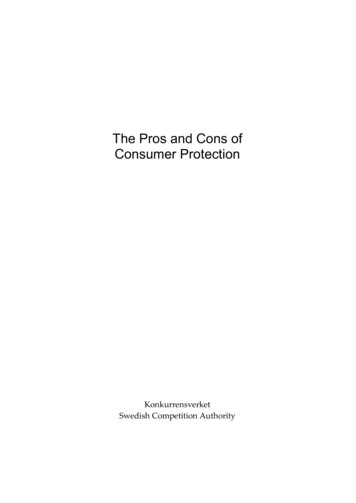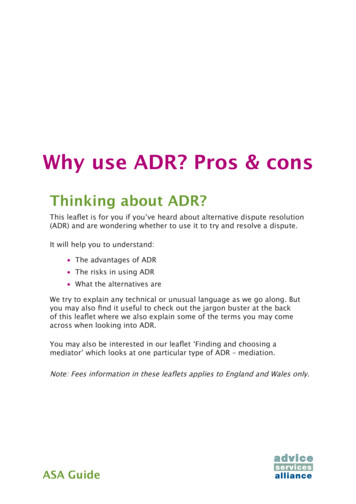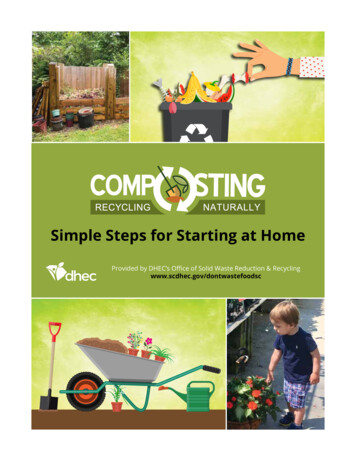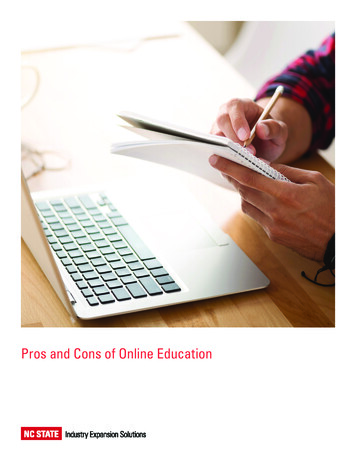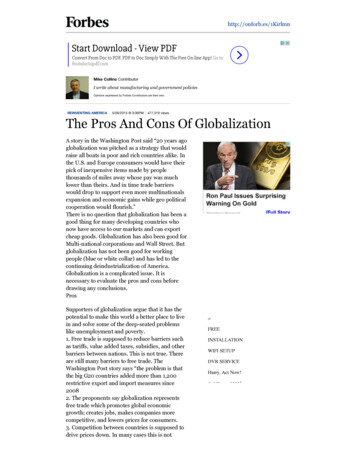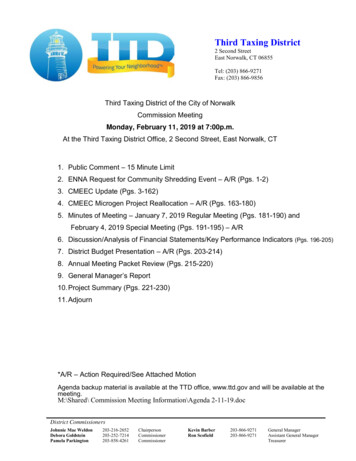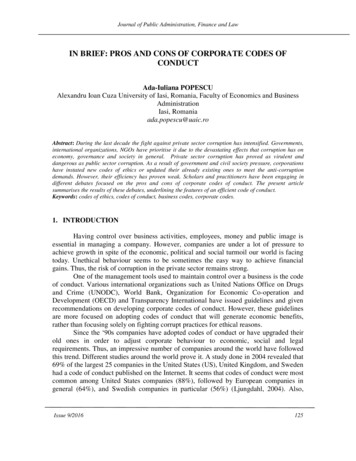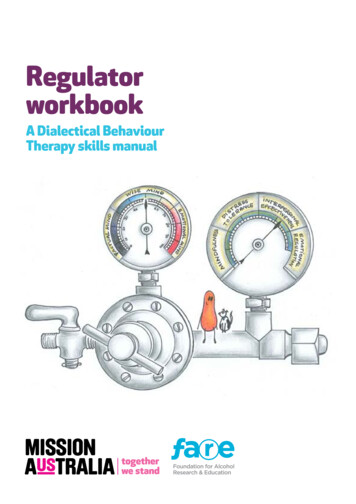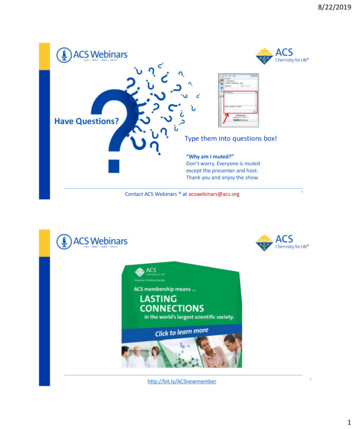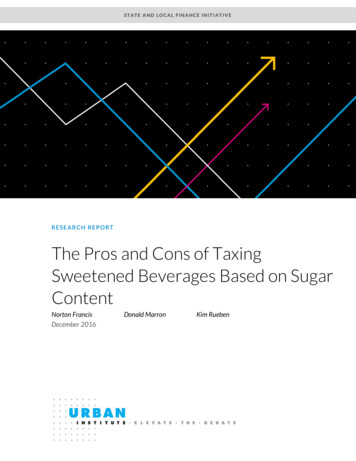
Transcription
STATE AND LOCAL FINANCE INITIATIVERE S E AR C H RE P O R TThe Pros and Cons of TaxingSweetened Beverages Based on SugarContentNorton FrancisDecember 2016Donald MarronKim Rueben
AB O U T T HE U R BA N I NS T I T U TEThe nonprofit Urban Institute is dedicated to elevating the debate on social and economic policy. For nearly fivedecades, Urban scholars have conducted research and offered evidence-based solutions that improve lives andstrengthen communities across a rapidly urbanizing world. Their objective research helps expand opportunities forall, reduce hardship among the most vulnerable, and strengthen the effectiveness of the public sector.Copyright December 2016. Urban Institute. Permission is granted for reproduction of this file, with attribution tothe Urban Institute. Cover image by Tim Meko.
ContentsAcknowledgmentsvExecutive SummaryviThe Pros and Cons of Taxing Sweetened Beverages Based on Sugar Content1Taxing Sugar Content Is the Least Costly Way to Reduce Sugar Consumption3Sugar Content3Previous Studies4Modeling Different Tax Approaches4Distributional Considerations6Business Responses and Reformulation6Taxing Based on Sugar Content Is Feasible at the National Level7Taxing Based on Sugar Content Raises More Issues at the State and Local Level but Is GenerallyFeasible As Well8Collection Points8Legal Authority9Cross-Border Coordination11Experience with Taxes Based on Content or Categories12ConclusionAppendix A. Modeling Policy Trade-Offs in Designing Sweetened-Beverage TaxesModel131515Strategy15Consumer Demand16Soft Drink Volumes, Prices, and Sugar Content16Pass-Through17Outcomes of Interest17Tax Designs18Results19Taxes That Raise the Same Revenue19Taxes That Achieve the Same Reduction in Sugar21Discussion and Limitations22Notes24References26About the Authors28
Statement of IndependenceIV30CONTENTS
AcknowledgmentsThis report was funded by the American Heart Association with additional funds from other generalsupport funders of the State and Local Finance Initiative. We are grateful to them and to all our funders,who make it possible for Urban to advance its mission.The views expressed are those of the authors and should not be attributed to the Urban Institute,its trustees, or its funders. Funders do not determine research findings or the insights andrecommendations of Urban experts. Further information on the Urban Institute’s funding principles isavailable at www.urban.org/support.We thank Maeve Gearing and John Iselin for contributing to our research, Michael Marazzi forediting, Ann Cleven and Sarah Gault for formatting, and Frank Chaloupka, Carter Headrick, RachelJohnson, Martin O’Flaherty, Barry Popkin, Mark Schoeberl, Jonathan Pearson Stuttard, and LaurieWhitsel for comments on earlier drafts.ACKNOWLEDGMENTSV
AbstractThe amount of added sugar in sweetened drinks varies greatly. If policymakers decide to use taxes onsweetened beverages to discourage consumption of added sugar, they should therefore consider basingthose taxes on the amount of sugar drinks contain rather than their volume. In this report, we analyzethe potential policy benefits of taxing sugar content; document how content-based taxes have beenused to discourage consumption of sugar, alcohol, and tobacco; and examine the legal and practicalchallenges of implementing such taxes at the federal, state, and local level. We conclude that taxingbased on the amount of added sugar a drink contains, either by taxing sugar content directly or bylevying higher volume taxes on drinks with more sugar, is feasible in many jurisdictions and reducessugar consumption more effectively than comparable taxes on drink volume. Broad-based volume orsales taxes on all soft drinks, however, raise revenue more efficiently. Federal, state, and localpolicymakers thus face trade-offs between using sweetened-beverage taxes to raise revenue and todiscourage consumption of added sugars.VIEXECUTIVE SUMMARY
The Pros and Cons of TaxingSweetened Beverages Based onSugar ContentThe rise in obesity and diabetes rates has prompted many proposals to reduce consumption of sugarydrinks. The idea of taxing sugary drinks has received particular attention. In recent years, France,Hungary, Mexico, the United Kingdom, and other countries have adopted sugary drink taxes. In theUnited States, soft drinks taxes have been enacted by four cities in California (Albany, Berkeley,Oakland, and San Francisco) as well as Boulder, Colorado, Philadelphia, Pennsylvania, Cook County,Illinois, and the Navajo Nation, and more jurisdictions are considering them.In this report, we examine the pros and cons of basing soft drink taxes on how much sugar a drink1contains rather than its volume or retail value. The vast majority of the sugar in drinks is added sugar.Our analysis thus applies equally to taxes on added sugar, which will become feasible once nutritionlabels are updated in 2018 and 2019. We make eight main points: Sweetened drink taxes are often based on drink volume, thus taxing high- and low-sugar drinksequally. But soft drinks differ greatly in their sugar content. Some have less than two teaspoonsof added sugar in each eight-ounce serving, for example, while others have more than seven.From a public health perspective, volume taxes thus do too little to discourage high-sugardrinks and too much to discourage low-sugar drinks. Focusing taxes on drinks with the mostsugar would do more to reduce sugar consumption for any given level of taxation. 2Taxes based on sugar content may also encourage manufacturers, distributors, and retailers toredesign their product lineups and marketing plans to favor drinks with less sugar. Suchincentives are more pronounced for taxes levied by jurisdictions with large beverage marketsthan by small ones. The federal government has both the authority and the capability to tax soft drinks based ontheir sugar content. The federal government has long taxed spirits based on their alcoholcontent and has experience applying different tax rates to different groups of products, such asspirits, wine, and beer. It could pursue either approach with sugary soft drinks.
Other nations have already enacted drink taxes based on sugar content. Hungary has a one-tier levy that taxes drinks with relatively high sugar levels. The United Kingdom recentlyannounced a two-tier levy that taxes moderate-sugar drinks at one amount and high-sugardrinks at a higher amount. And South Africa plans to tax the added sugar content of beverages.State and local governments, as well, often have the ability to implement taxes based on sugar content, but they face more constraints in implementing their tax policies. The tools available toa city or county can differ from those available to a state or nation because of legal limitations(e.g., statutory or constitutional limits on the taxes a jurisdiction can levy) and administrativeconstraints. The magnitude of taxes they can levy may be limited by the ability of consumersand noncompliant businesses to shift purchases to neighboring jurisdictions. When taxingmanufacturers based on sugar content is infeasible, local governments can consider tieredvolume taxes collected from distributors. Several states apply tiered taxes to wine and beerbased on alcohol content or divide alcoholic beverages into different categories for taxing.Many states include soft drinks in their sales tax base even when food for consumption at homeis excluded, applying the general retail sales tax to purchases.If policymakers are more focused on raising revenue than reducing sugar consumption, however, they may prefer broader taxes that spread the tax burden more evenly. Philadelphia’sdecision to tax all sweetened beverages, rather than just sugar-sweetened beverages (SSBs), isa good example.Policymakers thus face trade-offs among policy goals. Taxes that target high-sugar drinks provide the most sugar reduction relative to the economic burden placed on consumers. Taxesbased on sugar content minimize the cost of reducing sugar in soft drinks. But taxes based onvolume or price minimize the cost of raising revenue by taxing sweetened beverages.As soft-drink taxes become more common, individual jurisdictions may find the easiest path is to adopt the same design as neighboring jurisdictions. Such coordination will reduce theadministrative burden on both governments and businesses. But it also raises the importanceof identifying and implementing good tax designs early on, lest ad hoc choices lead jurisdictionsto miss out on better tax designs.In the remainder of this report, we present an economic analysis of different tax designs, documentthat taxing soft drinks based on sugar content is feasible for the federal government, and argue thatalthough taxing soft drinks based on sugar content may face challenges at the state and local level, it isgenerally feasible as well.2THE PROS AND CONS OF TAXING SWEETENED BEVERAGES BASED ON SUGAR CONTENT
Taxing Sugar Content Is the Least Costly Way to ReduceSugar ConsumptionTaxes on sweetened beverages are often based on drink volume. But sugar content varies greatlyamong beverages. A volume tax will increase the price of a high-sugar drink by the same amount as alow-sugar drink. Taxes linked to sugar content may therefore be a better way to discourage sugarconsumption because the price will increase as sugar content increases. To explore that possibility, wedocument the wide variation in sugar content in drinks, review previous research examining differenttax designs, develop and use a new model to examine the implications of different ways of taxingsweetened beverages, consider how concerns about consumers with low-income should inform taxdesign, and discuss the potential for taxes based on sugar content to inspire businesses to shift theirproduct lines toward drinks with less sugar.Sugar ContentSugar content varies greatly both across beverage categories and within them (table 1). A typical sugarsweetened soda, for example, contains almost 30 grams of sugar (about 7 teaspoons) per eight-ounceserving. A typical sweetened iced tea contains about half as much, and a typical flavored water containsone–third as much. Even within those categories, sugar content varies greatly. Some regular sodas haveless than 10 grams, while others have almost 50. And some sweetened teas have as much sugar as asugar-sweetened soda, while others have almost none. Basing a tax solely on drink volume thus ignoresthe diversity in sugar content and potential health effects.TABLE 1Sugar Content of Sugar-Sweetened Beverages, 2014Grams per eight-ounce servingRegular sodaFruit drinksSports drinksReady-to-drink teaEnergy drinksFlavored waterReady-to-drink 215191016Source: Rudd Center for Food Policy and Obesity, 2014, Sugary Drink FACTS 2014; authors’ calculations.THE PROS AND CONS OF TAXING SWEETENED BEVERAGES BASED ON SUGAR CONTENT3
Many public health experts believe that added sugars in foods and drinks pose particular risks.Nutrition labels, however, currently report total sugar, combining added and naturally occurring sugars.For practical purposes, drink taxes linked to sugar content must therefore be based on total sugar. Thatwill change, however, when added sugars are reported separately on nutrition labels. That reporting isscheduled for mid-2018 for major brands and mid-2019 for smaller ones. At that point, policymakerswill have the option of basing drink taxes on added sugar, with a fallback of taxing total sugar if addedsugar is for any reason not reported separately. Our analysis of the pros and cons of different taxdesigns applies almost identically to taxes on added sugar as to taxes on total sugar. The only slightdifference is that the base of a tax on added sugar would be slightly smaller because it would omitnaturally occurring sugars, such as from the milk in some sweetened drinks.Previous StudiesMost studies of taxing sweetened beverages focus on uniform taxes on volume or on taxes that raiseSSB prices by a specific percentage, usually 10 or 20 percent (Zhen et al. 2011, 2014; Dharmasena andCapps 2012; Lin et al. 2011; Finkelstein et al. 2013). In fact, we are aware of only one study that does ahead-to-head comparison of volume and sugar taxes on sweetened beverages. Zhen, Brissette, and Ruff(2014) compared a volume tax (0.5 cents per ounce) to a calorie tax (0.04 cent per kilogram calorie,3equivalent to 0.15 cents per gram of sugar). They calibrated these tax rates so the levy on regularCoca-Cola, the most popular sweetened beverage, would be the same under both approaches. Theyfound that taxing sugar would reduce sugar intake 8 percent more, impose 5 percent less of a burden on4consumers, and collect 5 percent less revenue than would taxing volume. Taxing sugar content thusdelivers more sugar reduction than a volume tax relative to the burden placed on consumers. In short,taxing sugar content is more efficient than taxing volume if the goal is reducing sugar consumption.Modeling Different Tax ApproachesUsing a simple model of consumer purchases of soft drinks, we explored how different tax designsaffect the amount of sweetened beverages consumers buy, the amount of sugar they consume fromthose beverages, the revenue collected by the government, and the economic burden on consumers(appendix A). The model groups sweetened soft drinks into six broad categories: zero-caloriesweetened drinks; regular soda; energy drinks; and noncarbonated sweetened beverages with high,medium, and low sugar content. These six categories keep the model relatively small and tractable while4THE PROS AND CONS OF TAXING SWEETENED BEVERAGES BASED ON SUGAR CONTENT
capturing important variation in sugar content and price. The three categories of noncarbonated softdrinks capture the particularly large variation in sugar content among fruit drinks, sports drinks, readyto-drink iced tea, ready-to-drink coffee, and flavored waters. Separating carbonated soft drinks intoregular soda and energy drinks captures the large price difference between expensive energy drinksand other sweetened beverages.We calibrated the model to conventional estimates of the price-responsiveness of consumerdemand for soft drinks and then simulated the effects of different tax designs. Consistent with manyprevious analyses, we focused on cases in which excise and sales taxes are both fully borne byconsumers; allowing for incomplete pass-through would change the magnitude of some effects, butwould not change the qualitative results.5The best tax design depends on the relative importance policymakers place on discouraging sugarconsumption, raising revenue, and minimizing new economic burdens on consumers. If policymakers want to reduce sugar consumption from sweetened beverages as efficiently aspossible, taxing sugar content is the best approach. Taxes on drink volume or sales are lessefficient because they do not reflect the wide variation in sugar content among sweetenedbeverages. For a given level of overall taxation, taxes on volume or price do too little todiscourage consumption of high-sugar drinks and too much to discourage relatively low-sugarones. If policymakers want to reduce sugar consumption from sweetened beverages with as littleeconomic burden on consumers as possible, taxing drinks with relatively high sugar content isthe best approach. Focusing the tax on high-sugar drinks maximizes the sugar reductionrelative to the consumer burden from higher prices. If policymakers are focused on raising revenue rather than reducing sugar consumption, a salestax on all sweetened beverages, including diet ones, is the best approach. Chicago has had a taxon the gross receipts of soft drink vendors since 1994. A close second is an excise tax on softdrink volume, similar to what Philadelphia recently approved. By including diet drinks in the taxbase, these broader taxes spread the tax burden, allow lower tax rates, and reduce theconsumer burden from higher prices. But they also do less to reduce sugar consumption thantaxes on sugar content.THE PROS AND CONS OF TAXING SWEETENED BEVERAGES BASED ON SUGAR CONTENT5
Distributional ConsiderationsPeople with lower incomes consume more sweetened drinks, on average, than those with higherincomes. Lin and colleagues (2011) find, for example, that lower-income adults consume about 40percent more sugary drinks each day than do higher-income adults. For children, the difference is moreextreme: kids in lower-income households consume two-and-a-half times as many sugary drinks as theirhigher-income counterparts.That pattern has mixed implications for sweetened drink taxes. On the one hand, it implies thatpolicies that reduce sweetened drink consumption may especially help vulnerable populations. On theother hand, it means that sweetened drink taxes are economically regressive, falling more heavily onfamilies with lower incomes than those with higher incomes (Marron, Gearing, and Iselin 2015).From a distributional perspective, therefore, the most attractive sweetened drink tax designswould be those that maximize the reduction in sugar consumption relative to the economic burden theyplace on families, particularly families with low incomes. Our modeling results suggest that concernabout consumers with low incomes should lead policymakers to prefer taxes that particularly targethigh-sugar drinks and thus deliver particularly large sugar reductions relative to the economic burdenthey place on consumers.Business Responses and ReformulationAlmost all quantitative studies of sweetened beverage taxes focus on how consumers respond. Butbusiness responses matter as well. With a volume tax, businesses have some incentive to design andmarket smaller packages, such as eight-ounce cans. With a tax linked to sugar content, however, theyalso have an incentive to reduce sugar content or to shift their marketing and promotion efforts tolower-sugar alternatives.Unfortunately, little systematic evidence exists on such responses. Hungary reports that its onethreshold tax prompted some companies to reduce the amount of sugar in their drinks to get below thethreshold (European Competitiveness and Sustainable Industrial Policy Consortium 2014). Moreover,proposed tax levels are very large relative to the price of sweeteners; high fructose corn syrup, forexample, costs about 0.1 cents per gram (USDA 2016), while the sugar content taxes we analyzed wouldbe about three times larger, around 0.3 cents per gram. Such a tax would be a meaningful incentive toreformulate products. And major beverage manufacturers have indicated that reducing average sugarcontent in their products is already part of their overall strategies.66THE PROS AND CONS OF TAXING SWEETENED BEVERAGES BASED ON SUGAR CONTENT
On the other hand, brand formulas are often determined at the national level by manufacturers,limiting the degree to which taxes by state and local governments may prompt reformulation. It is likelythat reformulation incentives would be more important for large states and the nation as a whole thanfor individual localities. But even local taxes may encourage lower-sugar formulations used by regionalgeneric or craft brands.Taxing Based on Sugar Content Is Feasible at theNational LevelThe US federal government clearly has the authority and capability to tax sweetened beverages basedon their sugar content. The federal government already taxes spirits based on their alcohol content, andit has long experience applying differential tax rates to categories of alcoholic drinks, motor fuels, andtobacco. Applying either approach to sugary drinks would be straightforward: the government wouldcollect the tax from drink manufacturers and importers.The feasibility of taxing drinks based on their sugar content is reinforced by the fact that severalother nations already do so. Hungary taxes SSBs at the equivalent of roughly 2 cents per liter if theycontain more than 8 grams of sugar per 100 milliliters, or about 19 grams per eight-ounce serving. TheUnited Kingdom recently announced that it would start taxing sugary drinks at the equivalent of 0.75cents per ounce if they contain at least 5 grams of sugar per 100 milliliters and about 1 cent per ounce ifthey contain more than 8 grams per 100 milliliters (those thresholds are equivalent to 12 and 19 gramsper eight-ounce serving, respectively). And South Africa recently announced a tax on sweetenedbeverages equivalent to about one-tenth of US cent per gram of added sugar.Together, those governments have enacted the three most promising ways to tax beverages basedon their sugar content: a single-tier tax (Hungary), a two-tier tax (United Kingdom), and a sugar contenttax (South Africa), all levied on manufacturers or importers. Other content-oriented nutrition taxesinclude Hungary’s single-tier taxes on products with other potentially harmful ingredients, includingsugar, salt, and caffeine; Mexico’s single-tier tax on energy-dense processed foods; and Denmark’s nowrepealed tax on the saturated fats used in food production.THE PROS AND CONS OF TAXING SWEETENED BEVERAGES BASED ON SUGAR CONTENT7
Taxing Based on Sugar Content Raises More Issues at theState and Local Level but Is Generally Feasible as WellState and local governments often have less financial and administrative resources than the federalgovernment, must operate within limits imposed by higher levels of government, and are constrained bythe fact that many businesses and some consumers produce, distribute, sell, or buy sweetened drinksbeyond their borders. These realities can limit the size of potential taxes state and local governmentscan effectively enforce on sweetened drink taxes. They also may affect the form these taxes can take, asit is likely that taxes will need to be based on information that is known or reported. On balance,however, state and local governments should find it feasible to base drink taxes on sugar content. Manyof the issues faced by state and local governments are not very different for a tax based on sugarcontent versus one based on volume, assuming the information needed to calculate the tax is easy toobtain.Collection PointsIn principle, soft-drink taxes can be collected from manufacturers (and importers), distributors, orretailers. Administration is usually easiest when taxpayers are few and large. For that reason, Mexico,South Africa, and the United Kingdom all apply their national sugary drink taxes to manufacturers. Thenational government knows who they are, and because they control the borders, collection from bothdomestic and foreign manufacturers is easier. Compliance checks are restricted to a few largetaxpayers rather than hundreds of distributors or thousands of retailers.At the state and local level, however, taxing manufacturers will not work because many are locatedoutside the taxing jurisdiction. A single Coca-Cola bottler, for example, might serve more than a dozen7states. Manufacturers sell through distributors and may not have the necessary legal or practical nexusto the jurisdiction to make a tax feasible.Although there are more distributors than manufacturers, distributers are more connected to aspecific community, so they can be identified more readily by local government officials. If they arelocated within a city, the city would have authority to tax them, and physical proximity makesidentification easier and reduces possible recordkeeping and compliance burdens. Because of space andaccessibility, however, distributors often operate warehouses near cities but not always within the cityborders. In Philadelphia, for example, this geography includes southern New Jersey. Distributors wouldhave to know which product goes to the taxable jurisdiction and have incentives to be willing to accept8THE PROS AND CONS OF TAXING SWEETENED BEVERAGES BASED ON SUGAR CONTENT
the burden of collecting and remitting taxes to a specific jurisdiction even if they are not legally boundby the jurisdiction (because of not being located within the geographic space). As with Philadelphia andNew Jersey, this becomes an interstate issue and it may be difficult to collect the tax from an out-ofstate vendor.8Collecting taxes at retail (whether framed as a tax on retailers or a tax on consumers) would betransparent and would ensure that all taxed businesses have a clear nexus with the taxing jurisdiction.9However, this would require collecting the tax from a large number of businesses, thus imposingrelatively large record-keeping and compliance burdens. Moreover, experience with other productssuggests that small retailers might be less able or willing to comply with the new rules. In the fiscal notefor a Texas proposal to impose a retail sugary drink tax in 2011, the analysis specifically mentions thecompliance difficulties retailers would face.10Berkeley and Philadelphia address this problem by requiring retailers to collect and remit the tax ifit is not collected from distributors. For example, Berkeley’s sugary drink tax is on the distributor withcareful language to ensure that the tax is only collected once (in some cases there may be more than onedistributor in the transaction chain). A retailer must show proof of tax paid or collect the tax itself.Because some retailers are exempt (those with gross receipts of less than 100,000), oneadministrative issue is that distributors need to identify those exempt customers.11Given these concerns, the most administratively practical approach for most cities and states wouldbe to follow Berkeley and Philadelphia’s lead and collect soft-drink taxes from licensed distributors tothe extent possible, holding retailers ultimately responsible if they purchase from noncompliant12distributors, warehouse stores outside the jurisdiction, or other untaxed sources. Thisrecommendation holds for any excise tax, whether based on volume, sugar content, or both. Thisapproach addresses the administration and compliance issue by having a smaller number of taxpayersand addresses the nexus issue by having a “backstop” of being able to collect from the retailer if thedistributor is out of reach. As is currently the case for cigarette sales, such an approach likely willinvolve some enforcement costs to the government to conduct random audits or checks of retailers.Legal AuthorityThere are both federal and local legal issues related to sweetened drink taxes. At the federal level,constitutional issues could arise regarding due process or equal protection (14th amendment) becauseof the singling out of sweetened drinks over other beverages. But courts have generally given statesTHE PROS AND CONS OF TAXING SWEETENED BEVERAGES BASED ON SUGAR CONTENT9
wide latitude in tax authority under the 14th amendment (assuming it doesn’t violate interstatecommerce provisions) as long as a rational basis for the tax exists and a clear distinction exists betweena taxable good and one that is not taxable. For example, alcoholic beverages are distinguishable byingredient content (alcohol) and have long been taxed separately from other beverages. The rationalebehind this, the desire to reduce alcohol consumption, is similar to the motivation behind sweeteneddrink taxes.At the local level, the issues are authority to tax and uniformity of taxable classes. Stategovernments have wide latitude over how and what they tax. Each state, however, establishes thetaxing authority available to local governments. Maryland, for example, allows counties to levy a tax onincome up to a maximum rate but not on sales. Alaska does not have a state sales tax but allows localgovernments to tax sales in their jurisdictions. California allows local governments to authorize someadditional taxes but only with direct approval of voters. And New York generally limits what localgovernments can tax although sometimes gives special taxing authority to some large governments. Forexample, New York City and Yonkers are allowed to levy a local income tax, and New York City isallowed to have an additional cigarette tax.13The legality of a recent sweetened drink proposal in Chicago was questioned. Opponentssuggested Chicago had reached the statutory limit on the amount of tax it could levy because the cityalready levies the maximum 3 percent surtax on bottled soda. Whether the cap refers to all taxes onsodas or just the soft drink occupational tax will undoubtedly be litigated if a future proposal succeeds.Several states also have uniformity clauses either by constitution or by statute that stipulate thatlike transactions have to be taxed equally. A good example is the tax on real property: some states allowproperty taxes to be different for commercial and residential properties, while some states withuniformity clauses may only allow one class. The definition and interpretation of a “class,” however, isleft to the courts. Pennsylvania has a uniformity clause in its constitution, and that clause has already14been raised by opponents of Philadelphia’s newly passed sweetened beverage tax. California has auniformity clause, but excise taxes are specifically exempted from it.15A tax on sugar content may be on stronger legal ground than a tax on volume for sweetened drinks.Basing a tax on the amount of an ingredient in a beverage does not create separate classes if there areno exceptions, whereas taxing based on natural versus added sugars creates beverage classes, as dotiered tax levels.10THE PROS AND CONS OF TAXING SWEETENED BEVERAGES BASED ON SUGAR CONTENT
Cross-Border CoordinationThe challenges of levying excise taxes grow as the taxing jurisdiction gets smaller. If a tax is high ordifficult to comply with, consumers and retailers have an incentive to acquire soft drinks outside thejurisdiction to avoid taxation. At the national level, tightly controlled borders make this difficult: entrypoints are few and monitored, and shipment sizes are ofte
2 THE PROS AND CONS OFTAXING SWEETENED BEV ERAGES BASED ON SUGAR CONTENT . Taxing Sugar Content Is the Least Costly Way to Reduce Sugar Consumption Taxes on sweetened beverages are often based on drink volume. But sugar content varies greatly among beverages. A volume tax will increase the price of a high-sugar drink by the same amount as a

